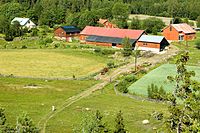
Photo from wikipedia
Evaluation of agricultural intensification requires comprehensive analysis of trends in farm performance across physical and socio-economic aspects, which may diverge across farm types. Typical reporting of economic indicators at sectorial… Click to show full abstract
Evaluation of agricultural intensification requires comprehensive analysis of trends in farm performance across physical and socio-economic aspects, which may diverge across farm types. Typical reporting of economic indicators at sectorial or the “average farm” level does not represent farm diversity and provides limited insight into the sustainability of specific intensification pathways. Using farm business data from a total of 7281 farm survey observations of English and Welsh dairy farms over a 14-year period we calculate a time series of 16 key performance indicators (KPIs) pertinent to farm structure, environmental and socio-economic aspects of sustainability. We then apply principle component analysis and model-based clustering analysis to identify statistically the number of distinct dairy farm typologies for each year of study, and link these clusters through time using multidimensional scaling. Between 2001 and 2014, dairy farms have largely consolidated and specialized into two distinct clusters: more extensive farms relying predominantly on grass, with lower milk yields but higher labour intensity, and more intensive farms producing more milk per cow with more concentrate and more maize, but lower labour intensity. There is some indication that these clusters are converging as the extensive cluster is intensifying slightly faster than the intensive cluster, in terms of milk yield per cow and use of concentrate feed. In 2014, annual milk yields were 6,835 and 7,500 l/cow for extensive and intensive farm types, respectively, whilst annual concentrate feed use was 1.3 and 1.5 tonnes per cow. For several KPIs such as milk yield the mean trend across all farms differed substantially from the extensive and intensive typologies mean. The indicators and analysis methodology developed allows identification of distinct farm types and industry trends using readily available survey data. The identified groups allow the accurate evaluation of the consequences of the reduction in dairy farm numbers and intensification at national and international scales.
Journal Title: PLoS ONE
Year Published: 2018
Link to full text (if available)
Share on Social Media: Sign Up to like & get
recommendations!